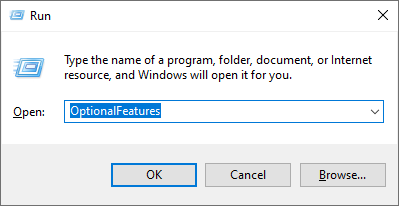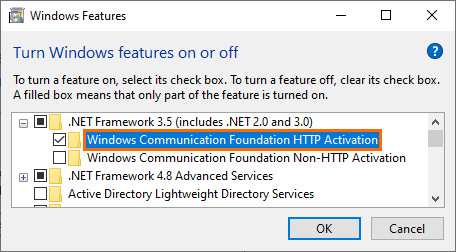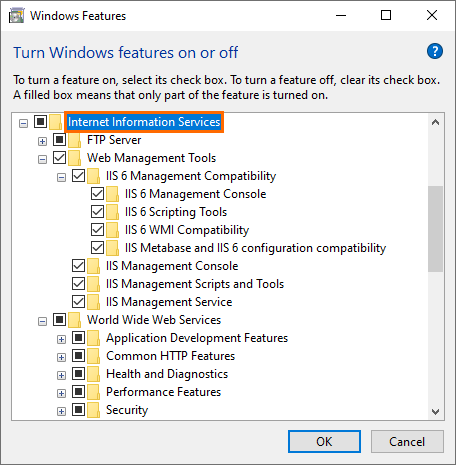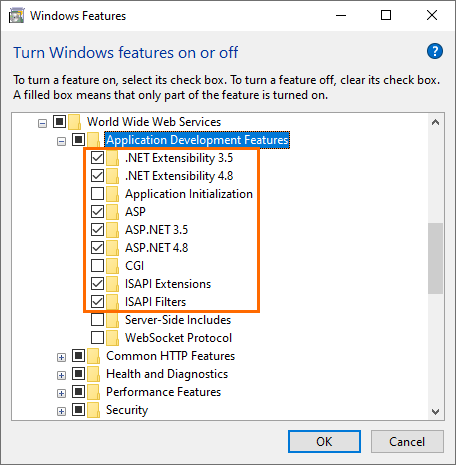
In order to use r_keeper_Dashboard, you should get the R-Keeper Dashboard package license at l.ucs.ru.
Starting from software version 11, the license is divided into Standard and Professional. For more details, contact the sales department.

The license will be requested automatically when entering the Dashboard section under Dealer ID.
If no IIS service is installed, this should be done.




With the use of registration program (aspnet_regiis.exe), available in the NET Framework 4.0 folder (usually, C:\Windows\Microsoft.NET\Framework64\v4.0.30319).
(You can also get familiar with it here: http://msdn.microsoft.com/ru-ru/library/k6h9cz8h(v=vs.100)).
For this purpose, launch aspnet_regiis.exe in the console with the specified parameter –i (see Fig. 5):
Fig. 5. Example of launching aspnet_regiis.exe from the console
If an error appears (see Fig. 6), use the add role and component wizard under the "WCF services" section to select the checkboxes in accordance with Fig. 7.
Fig. 6. Error during writing
Fig. 7. Add component wizard
This is used when installing the selected ASP.NET version and updating the IIS configuration at the root level for the purpose of using this version of ASP.Net.
2.2.5 Launching the IIS services manager from the execution dialog
To do this, proceed as follows:
1) From the "Start" menu, select sequentially "All programs", "Standard" and "Execute".
2) In the "Open" field, enter "inetmgr", and click "OK" (see Fig. 8).
Fig. 8. "Execute" window
In the IIS manager, the application pool should generate a relevant pool (UCS_AppPool) and use the .Net Framework 4.0 (or higher) environment (see Fig. 9).
Fig. 9. IIS services manager application pool
2.2.6 Installing Framework 4.0 (or higher) for IIS
Fig. 10. Installing Framework version 4 for IIS
2.2.7 Configuring compatibility settings
In the x64 operation system versions, select the checkbox controlling the compatibility with 32-bit applications for the pool used (see Fig. 11).
Fig. 11. Setting the 32-bit application compatibility flag
2.2.8 Make sure that the pool also has Framework 4.0 (or higher) installed
(see Fig. 12)
Fig. 12. Verifying the Framework 4 installation
2.3 RK7 manager station settings
2.3.1 For the purpose of correct r_keeper_Dashboard widget functioning, concepts and regions should be configured on the RK7 manager station. For this purpose, specify concepts and regions in the "Settings" – "Head office" directory (see Fig. 13, 14).
Fig. 13. Creating a new concept
Fig. 14. Creating a new region
2.3.2 Specify created concepts and regions in the restaurant properties ("Service" – "Stations & devices" directory) (see Fig. 15).
Fig. 15. Region and concept in the restaurant properties
2.4 WebInterface installation steps
1 Download the latest installer version from ftp://ftp.ucs.ru/rk7/other/dashboard/
2.1 Select the installation language:
Fig. 16.
2.2. Accept the license agreement terms:
Fig. 17.
2.3 Select "Install":
Fig. 18.
2.4 Select the parent directory:
Fig. 19.
If you want to choose another folder, click "Browse", and the following window appears:
Fig. 20.
You can also assign another instance name:
Fig. 21.
2.5 Select components (application installation for the IIS server):
Fig. 22.
2.6 Set the website association port:
Fig. 23.
Set the "Use https" flag to use a secure connection.
Note: do not use port 80, if you have Skype running.
2.7 Select the data source:
Fig. 24.
"IP address" — the database location IP address;
"Database name" — the name of the database;
"Login" — the database login name;
"Password" — the database access password;
"Restaurant code" — the corporate code (1 to 5 digits), and the object code (4 digits).
"Check the database connection":
Fig. 25.
Possible errors:
- database name error:
Fig. 26.
- incorrect password:
Fig. 27.
- incorrect IP address:
Fig. 28.
- no SQLNCLI11.1 provider installed:
2.8 Enter the Common Server settings:
Fig. 29.
"IP address" — Common Server IP address;
"HTTP port" — Common Server port.
Common Server connection error, report function server not found:
Fig. 30.
2.9 Select the report function server:
Fig. 31.
"Report function server" — the name of the database, where the report function server is connected to.
If the report function server version 1.25.1.0 or lower is selected, the "Next" button is inactive.
2.10 Select the shortcuts to be created on the desktop:
Fig. 32.
2.11 Install the Program on your computer:
Fig. 33.
When the following window appears, press any key:
Fig. 34.
2.12 The Program has been installed, click "Finish":
Fig. 35.
3 Updating WebInterface
WebInterface update steps:
2.1 Select the installation language:
Fig. 36.
2.2. Accept the license agreement terms:
Fig. 37.
2.3 Select "Update":
Fig. 38.
2.4 Enter the settings of the Common Server, previously installed by UCS:
Fig. 39.
2.5 Select the required report function instance:
Fig. 40.
2.6 The following window appears:
Fig. 41.
2.7 The Program has been updated, click "Finish":
Fig. 42.
4 Uninstalling WebInterface
WebInterface deinstallation steps
2.1 Select the installation language:
Fig. 43.
2.2. Accept the license agreement terms:
Fig. 44.
2.3 Select "Uninstall":
Fig. 45.
2.4 The following window appears:
Fig. 46.
2.5 The Program has been uninstalled, click "Finish":
Fig. 47.
5 Accessing the WebInterface application
The access to the WebInterface application is granted to:
1) Dealers using the Dealer ID/password;
2) r_keeper users with a specified e-mail in the user card:
Fig. 48.
6 Launching website with a web interface
6.1 A website with a web interface can be launched as follows:
- by means of shortcuts;
- via the IIS manager (see Fig. 49).
Fig. 49. Launching website from the IIS services manager
6.2 The following page appears:
Fig. 50. Application display in browser
"E-mail" — Dealer ID, or an r_keeper user e-mail;
"Password" — Dealer password, or an r_keeper user e-mail.
6.3 After the configuration is completed, WebInterface will display a link intended for the navigation to Dashboards.
6.4 When opening the WebInterface application, a list of sections appears:
Fig. 51.
6.5 When navigating to the Dashboard reports, the following window appears:
Fig. 52.
7 Installing r_keeper_Dashboard without installer
Software requirements:
RK7 version 7.5.4.166 or higher (when using the directory server);
RK7 version 7.5.4.180 or higher (when using report servers for the data transmission);
FS version 1.25.1 or higher;
WebInterface version 1.2.10 or higher. .
- (<add key="restaurant_code" value="XXXXX 0000 ") — corporate code (1 to 5 digits), and object code (4 digits) for license generation;
- (<add key="TimeOutQueryDb" value="700" />) — database request completion time (s);
- (<add key="AjaxTimeOutError" value="150000") — timeout of a widget request to the server (ms);
- (<add key="getLicensePeriod" value="180000" />) — license verification request timeout (ms);
- default_lang — default dashboards language [ru, en];
- fs_alt_lang — alternative r_keeper language [ru, en]
- enable_google_analytics — activation of Google Analytics
3. Edit IRReportsDLL.dll.config in the "bin" directory:
- databse connection string: <add name="connection_string" connectionString="Initial Catalog=SQL database name;User ID=**;Password=***;Data Source=ip address, 1433;Max Pool Size=1000" />
- specify <add key="instance_name"> — the application instance name; it should be the same both in r_keeper_7_Dashboard settings, and in WebInterface
- specify the paths to FS and CS, as well as report function server plugin version
Fig. 53. Adding an application
Fig. 54. Application properties
This component is mandatory (starting from Windows 8)!
Fig. 55. HTTP activation
9 After the configuration is completed, WebInterface will display a link intended for the navigation to Dashboards.
Fig. 56.
Navigate to the Dashboard reports.
Fig. 57.